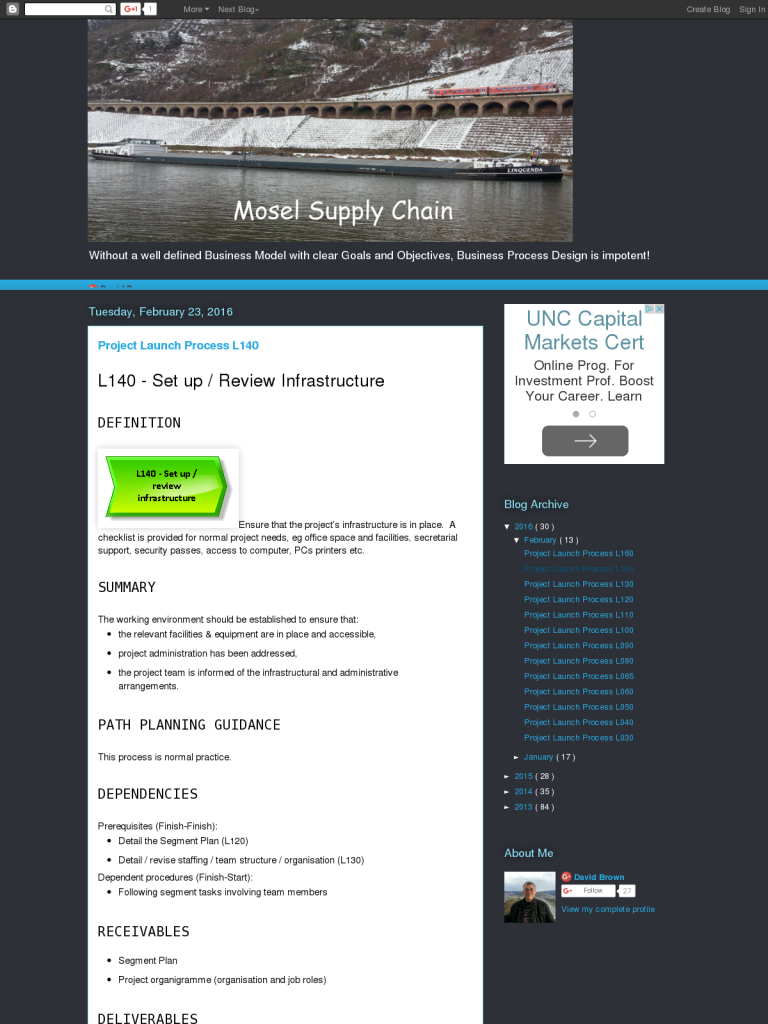Project Launch Process L140
Blog: Biz-Performance, David Brown
L140 – Set up / Review Infrastructure
DEFINITION
SUMMARY
The working environment should be established to ensure that:
-
the relevant facilities & equipment are in place and accessible,
-
project administration has been addressed,
-
the project team is informed of the infrastructural and administrative arrangements.
PATH PLANNING GUIDANCE
This process is normal practice.
DEPENDENCIES
Prerequisites (Finish-Finish):
-
Detail the Segment Plan (L120)
-
Detail / revise staffing / team structure / organisation (L130)
Dependent procedures (Finish-Start):
-
Following segment tasks involving team members
RECEIVABLES
-
Segment Plan
-
Project organigramme (organisation and job roles)
DELIVERABLES
-
Working environment for the project team
TOOLS
-
ITPM Core Guide
-
(checklist to be produced)
DETAILED DESCRIPTION OF TASKS
The project manager should review the requirements of the project and set up or secure the necessary project infrastructure, for example:
-
a suitable location for the project team, for example
-
providing ample accommodation for the full team,
-
preferably sitting team members in sub-teams and
-
with convenient access to key parts of the client organisation such as the project sponsor, the main user department management and staff, the IT department,
-
accommodation facilities would include
-
desks,
-
chairs,
-
shelving space,
-
lockable filing cabinets,
-
safe (if secure information will be handled),
-
white boards (per team),
-
flip charts,
-
access to specialised accommodation, for example
-
meeting rooms,
-
conference rooms,
-
presentation facilities,
-
training facilities (with ability to display computer screens and allow hands-on access to computer systems),
-
relevant equipment for example
-
PCs,
-
terminals,
-
printers,
-
network access,
-
personal software required,
-
telephones (with outside access),
-
some hands-free telephones for conference calls,
-
fax machine,
-
overhead projector,
-
portable “tablet” for displaying computer screens,
-
access to general office or accommodation facilities, for example –
-
photocopier,
-
internal and external mail services,
-
electronic mail services,
-
coffee, water, vending facilities,
-
restaurant,
-
toilets,
-
car parking,
-
sports and social facilities,
-
general office supplies, for example
-
computer and PC consumables – eg diskettes, paper, print cartridges,
-
stationery – eg paper, envelopes, folders, binders,
-
overhead projector slide making materials,
-
staplers,
-
hole punches,
-
pens, pencils, erasers, white board and flipchart marker pens
-
access to facilities for example
-
arranging security passes,
-
access to computer room,
-
project data included in backup procedures,
-
printing services,
-
communications services (eg company newspaper),
-
pooled typing and secretarial facilities.
Administrative details to be considered include:
-
signature authority for project manager and team leaders,
-
purchasing procedures, budgets and authorisations,
-
systems access – security permissions, usage budget etc,
-
interface with computer operations and management staff regarding access levels, service levels, scheduling runs, priorities, special needs, etc
-
work day schedules – days worked / standard hours etc,
-
arrangements for working outside normal hours – eg
-
permission , authorisation and supervision required
-
physical access,
-
overtime for project and other staff,
-
authority needed,
-
secretarial and administrative support,
-
travel and expenses guidelines,
-
communication vehicles,
-
interface with client organisation’s premises management department,
-
interface with client organisation’s personnel and line management regarding client organisation staff seconded to the project,
-
responsibilities for seconded staff, eg appraisals, holiday authorisation,
-
general management responsibilities, for example
-
timekeeping and attendance monitoring,
-
overtime returns,
-
telephone usage monitoring.
Relevant details should be communicated to the project team members and other relevant personnel. The details would normally be in a printed or electronic form so that they can easily be referred to or communicated.
Leave a Comment
You must be logged in to post a comment.








